Monitoreo y evaluación
La mayoría de desafíos de Monitoreo y Evaluación (MyE), tales como la falta de capacidades e inversión suficiente, no son específicos de los PTM. Sí los son aquellos que se refieren principalmente al monitoreo de los resultados de las transferencias sin restricciones. La flexibilidad de las transferencias en efectivo puede hacer que sea difícil determinar los indicadores de resultado apropiados, ya que ello puede implicar una combinación de indicadores sectoriales e intersectoriales. Al mismo tiempo, existen limitaciones en la recopilación de datos precisos sobre cómo se gastan las transferencias en efectivo.
Los firmantes del Gran Pacto se han comprometido a garantizar que existan mecanismos pertinentes de MyE para la asistencia en efectivo, y a incrementar el conocimiento de los costos, beneficios, impactos y riesgos de la misma en relación con otras modalidades. Sobre esta base, el grupo de trabajo del Gran Pacto sobre asistencia en efectivo dispone de puntos de acción, incluida la elaboración de indicadores de resultado comunes para el efectivo multipropósito, y métricas para el análisis del valor por dinero. El análisis sistemático del valor por dinero ha sido limitado por factores como la falta de criterios convenidos, la necesidad de datos de resultados de calidad y la naturaleza intensiva de los análisis.
Prioridades actuales
Como parte de los compromisos del Gran Pacto, la CALP Network ha coliderado con USAID y el Catholic Relief Service (CRS, por sus siglas en inglés) el desarrollo de indicadores de resultado de transferencias monetarias multipropósito. El borrador para prueba se encuentra disponible actualmente en inglés, francés y español en la biblioteca de CALP Network.
Iniciativas relacionadas
Contenido destacado

Multipurpose Cash Outcome Indicators – Final Draft for Testing
Guidelines and Tools
Note that the MPC indicators have now been revised. Please click here to access the updated Multipurpose Outcome Indicators and Guidance, which is available in Arabic, English, French and Spanish. Multipurpose Cash Outcome Indicators – Final Draft for Testing Multipurpose cash (MPC) is a type of assistance intended to enable people to meet their basic needs through local...

Monitoring 4 CTP: Monitoring Guidance for CTP in Emergencies
Guidelines and Tools
This guidance provides a central resource to promote a common understanding of the most important monitoring considerations for humanitarian projects using cash transfer programming (CTP). The primary audience for this guidance is field-level practitioners, from organisations directly involved in the design, implementation, monitoring, and accountability of projects using cash and vouchers...

Cost-Efficiency Analysis of Basic Needs Programs: Best Practice Guidance for Humanitarian Agencies
Guidelines and Tools
The Efficiency, Effectiveness and Value for Money Sub-Workstream is pleased to share the final output on Cost-Efficiency Analysis of Basic Needs Programs: Best Practice Guidance for Humanitarian Agencies (attached).
Cost-efficiency analysis estimates the ratio of program costs to outputs created, allowing you to compare cost-per-output for programs which all produced the same output. Such...
Líder temática
Últimos recursos
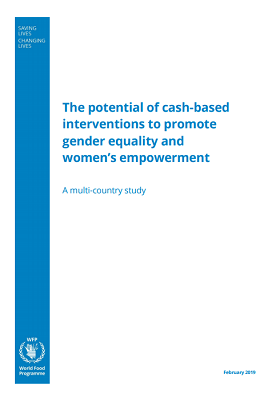
The Potential of Cash-Based Interventions to Promote Gender Equality and Women’s Empowerment
Report
The study on The Potential of Cash-Based Interventions to Promote Gender Equality and Women’s Empowerment sought to explore how CBIs can contribute to achieving gender equality and women’s empowerment (GEWE), as ends in themselves and for food security and nutrition outcomes. Where changes in GEWE...
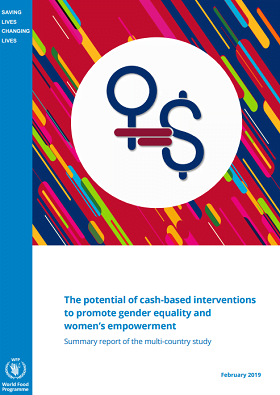
The Potential of Cash-Based Interventions to Promote Gender Equality and Women’s Empowerment – Summary Report of the Multi-Country Study
Report
The study on The Potential of Cash-Based Interventions to Promote Gender Equality and Women’s Empowerment sought to explore how CBIs can contribute to achieving gender equality and women’s empowerment (GEWE), as ends in themselves and for food security and nutrition outcomes. Where changes in GEWE...
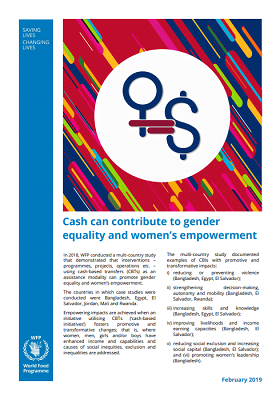
Cash Can Contribute to Gender Equality and Women’s Empowerment
Report
In 2018, WFP conducted a multi-country study that demonstrated that interventions – programmes, projects, operations etc. – using cash-based transfers (CBTs) as an assistance modality can promote gender equality and women’s empowerment. The countries in which case studies were conducted were...

Cash for Work (CFW) Guidance Note
Guidelines and Tools
Cash for Work interventions provide employment to unskilled and semi-skilled workers on labour intensive projects such as rehabilitation of irrigation systems, soil conservation, and road construction and maintenance.

Are there gendered impacts to multi-purpose cash transfers intended to build resilience?
Report
Brief from full report “The Gendered Dimension of Multi-Purpose Cash Supporting Disaster Resilience” extracting the specific gendered findings from a study on the impact of an EU funded project that used a “Cash Plus” approach, combining ten monthly multi-purpose cash (MPC) transfers with the...
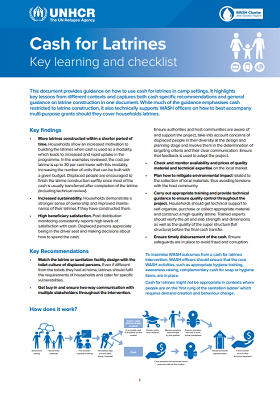
Cash for Latrines
Guidelines and Tools
This document provides guidance on how to use cash for latrines in camp settings. It highlights key lessons from different contexts and captures both cash specific recommendations and general guidance on latrine construction in one document.

ESSN Programme Technical Analysis
Report
The Technical Analysis study has been conducted with the aim of referring the individuals in the ESSN Programme beneficiary pool to the livelihoods in terms of its scope and content. With the purpose of increasing beneficiaries’ economic and social resilience and self-sufficiency by reducing their...

Analysis of social and power dynamics of stakeholders for the implementation of multi-year MultiPurpose Cash Transfers in North Mali
Report
Six INGOs (Hunger Against Action, Danish Refugee Council, Handicap International, Oxfam, Solidarités International and International Rescue Committee) have been implementing a MultiPurpose Cash Transfers programme in Mali; the second phase of this social safety net intervention targets the communes the...

Minimum Expenditure Basket Harmonization Guidance
Guidelines and Tools
The present Minimum Expenditure (MEB) Guidance is an operational tool for the Refugee Response to inform humanitarian multi sector and/or multipurpose cash assistance to meet food needs and a broader set of essential needs of refugees in Uganda.

The Digital Lives of Refugees: How displaced populations use mobile phones and what gets in the way
Report
GSMA in partnership with UNHCR conducted quantitative surveys and qualitative research to understand the ways in which refugees are using mobile phones in order to help guide digital interventions by humanitarian organisations and mobile network operators. The research identifies key trends, statistics,...

Evaluación Rápida de Mercado (RAM) – Área metropolitana de Bucaramanga – Santander
Informe
La población migrante se encuentra dispersa por toda el área Metropolitana de Bucaramanga, (tanto zona céntrica como barrios periféricos).
Objetivos del diagnóstico:
1. Identificar cadena de valor y nichos de oportunidad y brechas
2. Identificar principales actores en el mercado y apertura al cash...
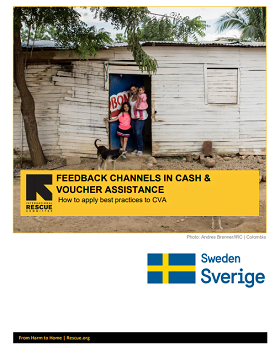
Feedback Channels in Cash and Voucher Assistance: How to Apply Best Practices to CVA
Guidelines and Tools
Accountability is at the core of effective humanitarian programming, and it is our duty to ensure that all programs – including those that use CVA to meet outcomes – are responsive to the clients we serve. While CVA is not inherently more risky than other forms of assistance, there are specific...

Cash Assistance and the Prevention, Mitigation and Response to Sexual and Gender-Based Violence
Report
The study Cash Assistance and the Prevention, Mitigation and Response to Sexual and Gender-Based Violence (SGBV) is based on comprehensive research in Lebanon, Ecuador and Morocco. It provides learning and recommendations when using cash assistance in the prevention, mitigation and response to SGBV. The...

Evaluación Rápida de Mercado (RAM) Barranquilla y Soledad, Atlántico
Informe
Según reportes oficiales, el Departamento del Atlántico alberga alrededor del 10.1% de población migrante, respecto al volumen nacional. El Atlántico y de manera especial la ciudad de Barranquilla y su área metropolitana han sido de las áreas más afectadas por los flujos de familias migrantes.
Las...

Reflections and recommendations from evaluations of the 2017 CVA Somalia Drought Response
Report
Improving our response to drought to avert crises through the use of cash and voucher assistance requires us to build on experience. This paper pulls together reflections and recommendations from a review of eight evaluation reports, reviews and studies that were conducted during or after the 2017 drought...

Evaluación Rápida de Mercado (RAM) – Cali y Yumbo, Valle del Cauca
Informe
La mayoría de población migrante venezolana está ubicada en las áreas urbanas más vulnerables. La población en condición de movilidad humana está dispersa por toda ciudad de Cali en especial la zona oriente, en los barrios del Distrito de Agua Blanca: Manuela Beltrán, Puertas del Sol y El Guabal....

6 Key Points to Address: Using Learning to Strengthen Cash and Voucher Assistance in the 2019 Drought Response in Somalia
Report
A summary of learning from Evaluation reports from the 2017 Somalia drought response.
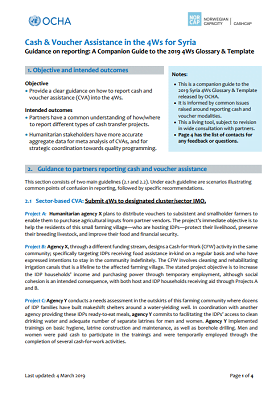
Cash & Voucher Assistance in the 4Ws for Syria Guidance on reporting: A Companion Guide to the 2019 4Ws Glossary & Template
Guidelines and Tools
Objective
• Provide a clear guidance on how to report cash and voucher assistance (CVA) into the 4Ws.
Intended outcomes
• Partners have a common understanding of how/where to report different types of cash transfer projects.
• Humanitarian stakeholders have more accurate aggregate data for meta...

Evaluación Rápida de Mercado (RAM) – Conurbación Bogotá-Soacha, Colombia
Informe
La población migrante se encuentra en las Comunas, 3, 4, 5 del municipio de Soacha (tanto zona céntrica como barrios periféricos). Lo mismo sucede en la ciudad de Bogotá aunque las localidades con mayor presencia son: Kennedy, Engativá, Suba, Fontibón y Bosa. Objetivos
1. Identificar cadena de valor...

Evaluación Rápida de Mercado (RAM) – Cúcuta y Villa del Rosario, Colombia
Informe
La población migrante se encuentra dispersa por toda la ciudad de Cúcuta (tanto zonas céntrica como barrios periféricos). En el municipio de Villa del Rosario están más concentrados en el área de frontera (La Parada) y centro. En ambos casos son áreas urbanas. Objetivos:
1. Identificar cadena de...



